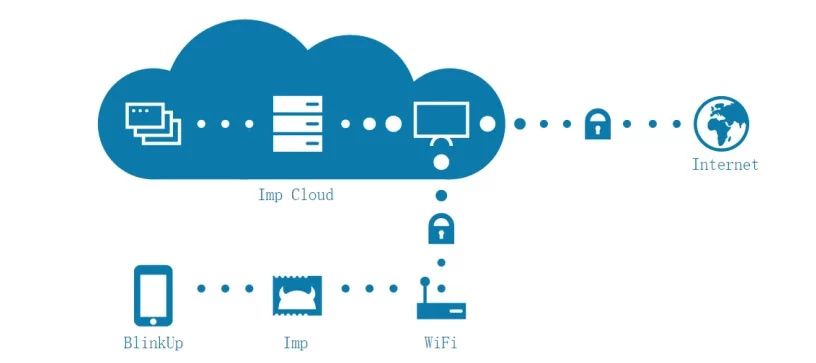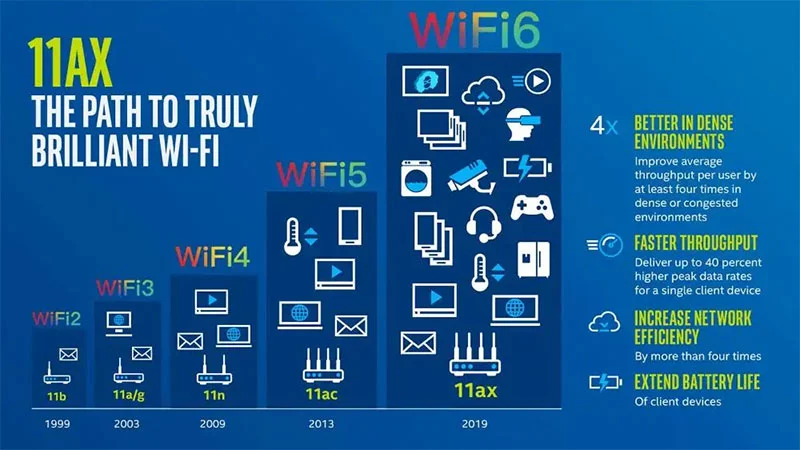This article gives you a comprehensive overview of WIFI technology and its applications, solutions, and FAQs in the Internet of Things.
In the era of the Internet of Things, when machines need to communicate, they do so in a language they can understand each other. That’s wireless communication technology.
The near-range wireless communication technologies widely used in the Internet of Things include WiFi (IEEE 802.11 protocol), Mesh, Bluetooth, ZigBee, NFC, UWB, etc. The WiFi module with wide coverage and fast data transmission rate is obviously the darling of wireless communication technology in the Internet of Things. Especially in the intelligent home terminal products in the application is more common.
What is WIFI technology?

Wi-Fi, the English full name is Wireless Fidelity, namely Wireless Fidelity technology. It is a technology that wirelessly connects handheld devices and personal computers to each other.
Wi-fi is a brand of wireless network communication technology to enhance the interoperability between wireless networking devices.
International Transport protocol standard
At present, WLAN field is mainly IEEE802.11x series and HiperLAN/X series of two standards, as well as China’s WAPI standard.
802.11 is for Wireless network communication. This standard has been enhanced to set up the 802.11x standard family since then. 802.11x is the technical basis of Wi-Fi.
WAPI standard
WAPI, Wireless LAN Authentication and Privacy Infrastructure(WLAN Authentication and Privacy Infrastructure) is a security protocol developed by the China Broadband Wireless IP Standard Working Group. It is also a mandatory wireless LAN security standard in China, approved by THE IEEE Registration Authority and authorized by ISO/IEC. This standard is a security encryption standard related to IEEE802.11b, but it is not compatible with the mainstream WEP and WPA formulated by the Wi-Fi Alliance. It is similar to the current 802.11i transmission protocol.
Data encryption technology
Because of the particularity of its physical topology, wireless networks cannot reach the security level of wired networks. Therefore, encryption and authentication are security considerations in wireless networks. The fundamental purpose of using encryption technology in wireless LAN is to make wireless service achieve the same security level as wired service.
2. Types of WiFi technology

1. WLAN
A WLAN is a LAN that transmits and receives data wirelessly without Network cables.
2. AP
Access Point (wireless Access Point), the device is the core device in wireless LAN, mainly used to connect with wired Ethernet, such as the Internet, and emit wireless signals. Within a certain coverage area, the signal from the AP can be received through a wireless network card.
3. SSID
SSID can separate a wireless LAN into several sub-networks. Independent authentication is required by each sub-network. If you want to enter the corresponding sub-network, then you need to be authenticated user. Prevent unauthorized users from accessing the network.
4. RSSI
Received Signal Strength Indication sends layer used to determine the quality of a link and whether to increase the intensity of a broadcast.
5.WPS
Wi-fi Protected Setup (Wi-Fi Protected Setup) is an optional authentication program organized by the WiFi Alliance to simplify wireless network Setup and encryption. In general, when a user creates a wireless network, to ensure the security of the wireless network, the user will set the wireless network name (SSID) and wireless encryption mode, that is, “Hide the SSID” or” wireless network connection password “. SSID and wireless encryption keys can be configured automatically with WPS.
This section describes key technologies of Wi-Fi 6
Wi-fi 6 is an evolution of the previous generation of WiFi technology. The protocol is named 802.11ax, and the operating band is 2.4GHz + 5GHz wi-fi technology. Wi-fi 6 has greater single-stream bandwidth, maximum modulation, MCS range and compatibility with up-and-down MU-MIMO and OFDMA compared to current popular WiFi technologies. All the advanced MIMO features of Wi-Fi 5 are inherited by Wi-fi 6 while adding many new functions for high-density deployment scenarios.
Wi-fi 6 has several core new features
01. OFDMA frequency division multiplexing technology
OFDMA evolved from OFDM and was first applied in communication technology. It is also used in the Wi-Fi 6 standard to make the spectrum more efficient. In the traditional way, each user sends data (no matter the size of the packet) will occupy the whole channel. As a large number of management frames and control frames are transmitted in the wireless network, these frames occupy the whole channel even though the packet is small, just like a big bus with only one passenger, as shown in the figure below:
OFDMA wireless channel technology will divide (a carrier), multiple sub channel form frequency resource block, user data bearing on each resource block, rather than take up the whole channel, so as to realize multiple users at the same time parallel transmission inside each time period, not waiting in line, competing with each other, enhance the efficiency, reducing the queuing delay.
02. DL/UL MU – MIMO technology
802.11AC Wave2 features Downlink Mu-MIMo as its AP node can send data packets to multiple mu-MIMO clients at the same time, eliminating the issue that wireless APS can only communicate with one terminal at a time.
Wi-fi 6 takes this technology and builds on it, supporting sending data to up to eight terminals at once. Uplink Mu-MIMo will also be supported on Wi-Fi 6, allowing up to eight 1×1 users to Uplink concurrently.
03. Higher order Modulation Technology
The 802.11ax standard target to reduce latency, improve efficiency, and increase system capacity in multi-user high-density scenarios. However, higher efficiency and higher speed are not mutually exclusive. 802.11AC uses 256-QAM orthogonal amplitude modulation, which transmits 8 bits of data per symbol (2^8=256). 802.11AX uses 1024-QAM orthogonal amplitude modulation, which transmits 10 bits of data per symbol bit (2^10=1024). The increase from eight to ten is 25%, which means that 802.11ax has a 25% increase in single-stripe data throughput compared to 802.11AC.
Orthogonal amplitude modulation demonstration of three different techniques
04. Space Division Multiplexing
Only one user is enabled to transfer data on a channel at one time. The collision avoidance is automatically implemented and the transmission is delayed if the Wi-Fi AP and the client listen for other 802.11 radio transmissions on the same channel. Hence, each user must take turns using the wi-fi radio. Hence, the channel is a very useful resource in the wireless network.
802.11ax can run in the 2.4GHz or 5GHz band (unlike 802.11ac, it can only run in the 5GHz band). Too few available channels may also occur in high-density deployment. The throughput of the system will be enhanced if the channel multiplexing capability is allowed to be improved.
Contrast 802.11AX with 802.11AC technology
Compared with 802.11AC (Wi-Fi 5), 802.11ax (Wi-Fi 6) makes WLAN network “efficient” through DL/UL OFDMA, UL MU-MIMO and space multiplexing. The rate is increased to 9.6Gbps by modulation enhancement without increasing bandwidth and flow number at the same time.
3. How does WiFi work

Like traditional transistor radios, WiFi networks adopt radio waves that have a longer wavelength in the electromagnetic spectrum than infrared light to transmit information via the air.
WiFi radio waves typically have a frequency of 5.8 GHz and 2.4 GHz. These 2 WiFi bands are then subdivided into multiple channels.
A wireless router first receives data from the Internet over your broadband Internet connection and then converts it into radio waves. The wireless router then emits radio waves into the area around.
WiFi networks can be disrupted by interference from other various electronic devices or WiFi networks since WiFi relies on radio waves.
To ensure the best WiFi performance, network administrators often turn to WiFi analyzer apps like NetSpot to view, manage, and troubleshoot WiFi connections. NetSpot produces WiFi network, highlighting areas where the signal is weak. In today’s ubiquitous WiFi era, tools like NetSpot are essential for setting up even basic home WiFi networks.
4. Comparison between WiFi technology and Bluetooth technology

If you compare WiFi and Bluetooth, what are their similarity and differences? Imagine It will be technologies like these never exist, it would be a world of time-consuming dial-up connections, seemingly endless downloads, slow-loading Web pages, and endless wires connecting multiple devices. WiFi and Bluetooth are necessary in our connected world. Our daily lives are affected in many areas.
Does Bluetooth need WiFi? No, it doesn’t
Bluetooth itself is not dependent on an Internet connection although some devices may have WiFi and Bluetooth capabilities. WiFi and Bluetooth wirelessly connect electronic devices. However, their operations are different. Let’s read on.
Understand the WIFI
WiFi is a wireless technology that enables devices to connect to the Internet via WiFi routers. WiFi signals are transferred by Internet service providers to routers to allow devices like tablets, laptops, computers, and phones to be accessed over the Internet. WLAN can be created by these devices. The network ranges from 150 to 300 feet.
WiFi itself is new while the history of the Internet dates back to the creation of the ARPANET by the US Department of Defense in the 1960s. It was introduced to consumers as “WiFi 1” in 1997 with the PUBLICATION of IEEE 802.11, a LAN standard.
The non-profit WiFi Alliance was founded in 1999. The WiFi Alliance certifies newly manufactured WiFi devices by conducting tests on other devices connected with WIFI. Regard interoperability as the ability of 2 or more devices to work seamlessly without interfering with each other.
The need for speed
While the original WiFi routers ran at 2.4 GHz (2.4 billion waves per second), some WiFi routers today run at 3.6 GHz or 5 GHz. 5ghz routers can achieve a throughput of 3.5Gbps (gigabit per second), while the next generation 6ghz routers have the potential to run 250% faster at 9.6Gbps. WiFi 6 offers higher network efficiency, longer battery life, and faster data transfer.
Internet speed is getting more and more essential because more households expand the number of connected devices in their networks. So how important is it to speed up WiFi?
Understanding of Bluetooth
Bluetooth connects devices directly to each other, rather than through WiFi routers. Bluetooth operates as a short-range radio. It can connect to more than 8 different devices after sending and receiving encrypted data via an embedded computer chip inside the device.
Bluetooth enables you to wirelessly connect your keyboard to your laptop, control the volume of your speakers via an app on your phone, connect your phone to your car’s sound system, and more.
How does Bluetooth compare to WIFI?
Bluetooth has a much shorter range and a much slower transmission rate when compared to WiFi. That means Bluetooth batteries last longer and are not nearly as long. That’s what makes Bluetooth devices so small.
Bluetooth is designed to eliminate cables and wires. Dr. Nils Rydbeck introduced the first Bluetooth protocol through hands-free headphones in 1999 with Dr. Johan Ullman and Dr. Jaap Haartsen.
SIG was formed by Nokia, Ericsson, Toshiba, Intel, and IBM on November 13, 2000.
Bluetooth and WIFI
Like WiFi, Bluetooth runs at 2.4 GHz. Bluetooth has no signal interference problems in the 2.4ghz spectrum. Baby monitors, garage door openers, electronic toys, wireless earplugs, microwave ovens all use the 2.4ghz frequency.
How does Bluetooth get around this interference?
Bluetooth uses FHSS, which transfers signals that can only be decrypted by the Bluetooth device that sends and receives them. FHSS signals alternate between 79 different channels.
Bluetooth’s FHSS technology is the reason that you are allowed to type on a wireless keyboard and listen to your phone through a wireless earplug with a wireless mouse without any interference. This network of Bluetooth devices is Piconet. The Bluetooth protocol in the device determines who is the master and slave device.
An electronic conversation takes place immediately whenever you “pair” a Bluetooth wireless device. Whether data needs to be shared, conversations are designed to build trust between devices and decide. Bluetooth FHSS technology ensures that your piconet does not interfere with other micronets in the same vicinity.
WIFI and Bluetooth: a better combination
WiFi eliminates dialing, while Bluetooth eliminates wires. Both are complementary radio frequency devices. Everyone can help us stay connected in real-time, be more productive at work, and enjoy our leisure time. We’ve gotten so used to depending on both Bluetooth and WiFi that the old dial-up and wire of the past are just a distant memory.
5. WIFI 6 is introduced

What is Wifi6?
WiFi 6 is the latest 802.11ax wireless communication technology standard released in 2019. It is a new naming method developed by the WiFi Alliance. At the same time, for the convenience of memory, the previous generations also simplified naming:
We now commonly use 802.11AC – WiFi 5
802.11n — WiFi 4
3-802.11 g WiFi
802.11 – the WiFi 2 a
802.11 – the WiFi 1 b
What’s so good about Wifi6?
Speed is fast
Compared to the previous generation of WiFi5, WiFi 6 can theoretically transmit at up to 9.6Gbps, nearly three times higher.
This means that under the new standard, you will never feel stuck in real life (file, watch video). However, you’ll need a WiFi 6 enabled device first.
The upper limit of network speed has been increased
Compared with WiFi 5, WiFi 6 standard further enhances MU-MIMO technology and supports upload and download (WiFi 5 only supports mu-MIMO during download) to improve wireless network bandwidth utilization. In addition, a maximum of eight antennas are supported to transmit data, greatly increasing the upper limit of network speed.
Ease Network congestion
WiFi 6 uses OFDMA (orthogonal frequency division multiple access) technologies to increase network capacity and effectively solve data congestion and delay.
For example, in the past, WiFi was a supermarket checkout, which could only process one person’s fee at a time, while those behinds could only wait in line. WiFi 6, which uses OFDMA technology, is like multiple supermarket check-outs that can handle multiple people’s bills at the same time. This also results in great efficiency enhancement.
More secure
To be certified by the WiFi Alliance, WiFi 6 devices must use WPA3, so most WiFi 6 devices will be more secure once the certification program starts. (From Baidu Encyclopedia)
This means that when we use wireless networks in public places like airports and coffee shops, hackers won’t be able to snoop on our data thanks to WPA3.
Improve equipment life
WiFi 6 also introduces Target Wake Time (TWT) technology, which enables the wireless router to open the connection only when receiving the transmission command, and then go to sleep to reduce power consumption. However, mobile phones, laptops and other devices require constant access to the Internet, so TWT technology is not evident on these devices; And for now, popular smart home can greatly improve the battery life.
conclusion
To put it simply, WiFi 6 is the 6th generation of wireless network technology. Relying on technological innovation, it has greatly improved the transmission speed, communication quality, multi-device access and security of wireless network. With WiFi 6 enabled routers, WiFi 6 enabled mobile phones, computers and other wireless devices, and gigabit broadband, you’ll have a flying Internet experience.
6. Why WIFI

There are forecast to be over 5 billion connected devices by the end of this year. Lack of standardization, security, battery life, integration, and rapid growth are challenges that IoT is facing. Just 16 years old WiFi is ready for IoT, which is probably the best network for IoT.
IoT may be the buzzword these days, but the quest for connected things is nothing new. AutoID, connected Coca-Cola vending machine, M2M, Caller ID, smart meter, RFID, etc. The appeal of connected devices is efficiency and experience, which people crave more than ever. We live in an age of experiences where patience is scarce and we want things around us to be “good experiences” and “efficient” and only IoT can deliver that. IoT is an intelligent and invisible network where things are directly or indirectly connected to each other for experience and efficiency.
IoT is facing challenges as below:
Used to connect devices or cloud computing
Devices in the Internet of Things often have some form of embedded technology that allows them to sense things like pressure, humidity, temperature, movement, and the number of people in the area. And then there’s a technology that allows them to connect to cloud computing or other devices that allows them to send that information and program it. There are many proprietary technologies and standards for connecting devices or connecting to the cloud: Bluetooth, Wi-Fi, ZigBee, Active RFID, IoWPAN, EtherCAT, NFC, etc. The preferred technology is usually determined by the physical properties of the environment, such as wood, concrete, metal, etc. Of these technologies, Wi-Fi is the most promising one. Now Wi-Fi has become the standard for the popularity of the Internet. It is used in homes, businesses, schools, hospitals, airports and so on.
But any Active RFID technologies that operate lower than the 1-GHz band are also used for connectivity because the number of devices from the device to the access point is limited. A large number of devices and a much larger range is enabled by active RFID technology.
802.11ah is being developed to leverage the 900MHz band, which will address the need to connect a large number of devices over long distances. A typical 802.11ah access point can connect over 8,000 devices in a 1-kilometer range, making it ideal for high-density networking environments. The Wi-Fi Alliance promises to roll out the standard soon. After the launch of this standard, Wi-Fi is likely to become the preferred technology for IoT.
And, remember, the Development of the IoT is just beginning. We are growing fast, but there are many unknowns in the future. Going forward, the best approach is to use common global standards for the Internet of Things and application programming interfaces so that these devices can communicate with each other and connect to the cloud without upgrading network infrastructure. Standardization and interoperability are one of the main reasons why Wi-Fi is so popular, and another reason why iT fits the Internet of Things.
Security and privacy requirements brought about by IoT
The Internet of Things has created a borderless world in which everything can communicate with cloud computing. Device or network administrators may not even know the operating or firmware system of those devices or the cloud computing applications they interact with. It’s a challenge to protect privacy and prevent malicious behavior.
Administrators may not know what other information these devices will send or how that information will be used. Too many cloud applications, too many APIs, and too many attackers. SDN is the most natural solution to security and privacy concerns, and in the past few years, the industry has made progress in implementing WiFi around SDN(Software Defined Networks). With SDN, Wi-Fi can achieve uniform policy management so that IoT device traffic can be scanned and protected at network access points.
Without energy efficiency, the cost of maintaining the equipment would be too high
Since most of these devices need to be removable or self-maintained, extended battery power is a necessary thing. Batteries can’t be replaced every few days or weeks, and it’s best to use solar, wind, heat and electricity. There has been a lot of effort in the industry to make Wi-Fi more low-power, and many vendors are now focusing on low-power Wi-Fi chipsets. In addition, 802.11ah can contribute to low power consumption, where the latest innovations around scattered Wi-Fi can be used to achieve low power wi-fi with no power or battery assist.
All in all, given its potential to solve all these challenges, Wi-Fi seems to be the most appropriate choice for the Internet of Things.
7. Advantages and disadvantages of WIFI Internet of Things

Advantages of WiFi network
Wireless networks provide many opportunities as well as the freedom to use the accessibility and Internet. You must have a wireless router and receiver antenna no matter what device you use. Here are some advantages to knowing about WiFi over wired networks.
Convenient WiFi network
Multiple users can connect to a router or via hotspot technology without any configuration over a wireless network. It’s got easy to use. This ability to connect over a wireless network effectively replaces wired or wired networks, which take more time to configure and allow connections in multi-user environments.
Work flexibility
One of the benefits of WiFi is the flexibility it provides in the workplace. Don’t stay in one place and work. Sometimes finding an RJ-45 or network cable to plug into a desktop or or desktop can be a hassle. A WiFi device installed in the workplace provides service for each user, allowing the workflow to continue without any hindrance.
Increase productivity
Employees can easily maintain their work because they needn’t waste time with LAN connection issues or server. If multiple users access the same network, IP address conflicts are least likely. Work can be performed from anywhere, from sending emails to selling meetings. This can also affect productivity when delivering goals and work on time.
WiFi provides mobility
Can take work anywhere from the cabin to the cafeteria without having to sit in front of a computer to complete tasks. Things can also be automated through your phone. The WiFi connection makes it possible to conduct transactions via mobile devices, as the technology works with every smart device that integrates with the surrounding WiFi network. You can send bank transactions, emails, and check work reports while on the road.
WiFi is easy to deploy on the infrastructure
A single WiFi access point is good for getting rid of plans and maps for laying cables and switches in the workplace. Consider that the new cabin has been moved from its current position and a new connection must be installed. Mapping and installing complex wired networks can be difficult compared to just installing wireless devices in the cabin.
WiFi is cost-effective
The obvious benefit of a wireless LAN is that the cost of building a new network is minimal. Cabling costs can be reduced, labor costs can be reduced, and time saved, and most importantly because the process does involve all three factors that affect the company’s new organizational budget.
Extensions and additions
New users can be added to the WiFi network at any time. Granting access to users with wireless LAN credentials to make them authorized users is the thing you should do. The time and effort involved in wiring users will be minimized and connectors will be added.
Wireless LANs are easy to relocate
Wireless LAN networks are easy to maintain and move even if you plan to move your company to another building or location. Even though buildings are being refurbished and rebuilt, work remains unaffected. You can still execute the workflow without worrying about wiring and connection issues. This feature can also save a lot of time, money, and energy to help focus on business and related tasks.
The disadvantage of WiFi
Wireless LAN technology is always convenient, but sometimes you may need to handle WiFi’s limitations. What are those disadvantages? The following are some of the problems (disadvantages) that may be encountered.
Security issues
Most open WiFi networks are unsafe to connect to because it is not known who is connected to the network. Public WiFi networks tend to hack. Hackers may impersonate their ids as network ids, which can also cost people or businesses. Hence, it is best to do business only on business or private networks.
Limited coverage
The second most common disadvantage of wireless LANs is range issues. As the building has a multi-story structure. The typical WiFi ranges from100 to 150 feet in a building. When away from the access point location, the range and strength of WiFi devices decreases. If you are not in network range, you will not be able to connect to the network, which may interfere with the workflow.
interference
Wi-fi devices typically operate at 2.4 GHz and may be interfered with or blocked by other electromagnetic devices or walls between them and the WiFi source. This signal problem can cause connectivity problems, or it can cause signal strength to be weak and slow down. In this case, transferring large files over the network is risky. In this case, the data is tend to be corrupted in transit.
Bandwidth usage
The more devices connected to a single WiFi network, the weaker the bandwidth. This is one of the obvious drawbacks of WiFi in the workplace. More users mean limited speed limits and slow workflows.
Slower than LAN
At work or at home, wireless LANs are slower than wired networks. Most wireless signals are either distributed or dissipated due to other devices or external EMF sources. A 2011 study called “Home WiFi” also found that WiFi Internet connections can be 30 percent slower than wired ones.
The health effects of WiFi
WiFi can cause testicular/sperm damage, and neuropsychiatric effects on human health, according to research recently published in Science Direct. Other WiFi health hazards include cellular DNA damage, apoptosis, calcium, and endocrine change overload.
8. Application cases of WIFI technology in the Internet of Things
At present, there are many WiFi wireless communication modules for the Internet of Things on the market. Esp32-s3 module can connect users’ physical devices to WiFi wireless network for Internet and LAN communication. The module is mainly used in intelligent transportation, smart power grid, industrial control, smart home, handheld devices, and other fields.
Esp32-s3 integrates 2.4ghz Wi-Fi (802.11b /g/n) and supports 40MHz bandwidth; Its low-power Bluetooth subsystem supports Bluetooth Mesh and Bluetooth 5 (LE) and can communicate over long distances with Coded PHY and broadcast extensions. It also supports 2Mbps PHY for increased data throughput and transmission speed. The esp32-S3’s Wi-Fi and Bluetooth LE RF performance is superior and works reliably at high temperatures.
Esp32-s3 is a WiFi module that integrates 2.4GHz Wi-Fi (802.11b /g/ N) and supports 40MHz bandwidth. It supports data transmission between serial ports and WiFi. The module integrates MAC, radio frequency transceiver, baseband processing, WiFi protocol, network protocol stack, and configuration information. Users are enabled to easily realize the wireless network function of serial port equipment by using it, make the product put into the market faster.
Traditional serial port devices can transfer data over the Internet without changing any configuration with the ESP32-S3 module Provide a fast solution for users’ serial devices to transfer data through the network.
When selecting a WiFi module for the Internet of Things, we should pay attention to the parameters of WiFi module: size, package, frequency range, data rate, transmission rate, transmission distance, communication interface, power supply voltage, antenna interface, etc.
The prospect of the Internet of Things is high and far-reaching. New functions and application layers are emerging in an endless stream, and WiFi modules are entering the field of the Internet of Things at a faster pace. Feirui technology agent lexin products, in the intelligent home, intelligent medical, intelligent security, intelligent industry and other fields mature to provide customers with WiFi module research and development and production solutions and has received a positive response from the market.
A few years ago, you might have asked how close is the Internet of Things to landing. Now, the Internet of things is all over our lives. WiFi is more like a large network. In life, as long as intelligent terminal devices are used, there will be WiFi.
The availability and popularity of WiFi is an advantage unmatched by other wireless technology protocols. With the development of the smart homes, Wi-Fi modules will become the protagonist in the field of wireless interconnection in the future.
9. WIFI IoT solution

Intelligent home solution of Internet of Things based on WiFi module
The Internet of Things is based on the interconnection between objects, and its simple, stable and reliable networking capability is one of the most important factors in its development. The wireless Internet of Things is important because of the wide distribution of devices and objects connected to the network and the advantages of wireless communication technology in terms of networking convenience.
The pace of smart home products is gradually accelerating, and the market demand for wireless modules will also show an increasing trend. The smart home solution of the Internet of Things based on the WiFi module basically supports home and remote control modes.
At home, how does WiFi in smart home products/devices connect to WiFi in home routers? There are two ways to connect APP (SmartLink smart home mode) and AT instruction set.
SmartLink is an intelligent networking technology that connects WiFi modules to wireless routers. The SSID and password are encrypted with broadcast packets and sent through broadcast packets.
UDP can send broadcast packets at the application layer. Hence, the PC program or APP sends a UDP packet and places the SSID and password in the packet. After receiving the packet, the intelligent device parses the packet to obtain the SSID and password and can configure and connect to the router.
The booming application of the Internet of Things has also brought a new round of wireless communication technology business opportunities. More and more chip makers (such as processors and microcontroller MCUS) are trying to accelerate the development of WiFi/BT/ZigBee technologies to tap into the iot market.
Products and solutions such as integrated wireless single-chip MCU, integrated MCU and wireless function modules, integrated embedded processors and wireless single-core SOC have blossomed in an all-around way.
WiFi module belongs to the transmission layer of the Internet of Things. The serial port or TTL level is converted into an embedded module that conforms to wi-fi wireless network communication standard and IEE802.11 protocol stack network standard. The built-in TCP/IP protocol stack can realize any transparent conversion. Enable traditional serial devices to better join the wireless network.
10. The history of WIFI

In the past 20 years, with the rapid development of WiFi technology, our mobile phones, laptops, ipads and other wireless networks can access the Internet at high speed, which has greatly changed our way of life and become an essential part of our life
In the 1990s, IEEE established a dedicated 802.11 group to study and customize WLAN(wireless local area network) protocols and specifications, and subsequently launched various generations of WiFi protocols
1. In 1997, the 80.11 group introduced the 802.11 protocol. WLAN was originally only in the 2.4ghz band with a maximum speed of 2 Mbps
2. 802.11a protocol was introduced in 1999. In order to improve the rate of wireless transmission, WLAN operates in the 5GHz band (single band), with the highest transmission rate reaching 54 Mbps. In the same year, 802.11b was introduced for 2.4ghz WLAN, which increased the maximum 2.4ghz speed to 11Mbps
At the same time, another important event was the establishment of the Wi-Fi Alliance this year, the official birth of the word WiFi
3. In 2003, 802.11g protocol and OFDM technology were introduced. 802.11g is the first dual-band WiFi protocol, supporting both 2.4ghz and 5GHz, inherits the highest 54Mbps transmission rate of 802.11b’s 2.4ghz band and 802.11a’s 5G band. It is also backward compatible
OFDM (Orthogonal Frequency DivisionMultiplexing) technology, is by MCM (Multi Carrier Modulation, Multicarrier modulation (developed from a low implementation complexity, the most widely used multicarrier transmission scheme
4. Introduced 802.11n protocol in 2009. New technologies include MIMO, MCS and Beamforming
802.11n adds MIMO technology and supports 40MHz bandwidth, with speeds up to 600Mbit/s when using 40MHz bandwidth and 4*4 MIMO
5. Launched 802.11AC (WiFi 5) protocol and MU-MIMO technology in 2013
WiFi 5 protocol 5GHz band single antenna maximum rate of 866Mbps, 8*8 MIMO (8T8R) theoretical rate of 6.9 Gbps. While 802.11AC provides good backward compatibility, the 5GHz band width is increased to 80MHz (the highest is 160Mhz, but the chip manufacturer only implemented 80MHz band width; WiFi 6 was commercialized to 160Mhz band width on a large scale), and the modulation mode is upgraded from 64-QAM to 256-QAM.
In 2019, 802.11ax (WiFi 6) protocol, OFDMA technology and MU-MIMO upgrade
WiFi 6 single stream (1T1R) up to 1200 Mbps, (8T8R) up to 9.6Gbps, mainly has the following features:
Low latency (MU-MIMO technology and OFDMA support)
Low power consumption (TWT technology, mainly reflected in the optimization of IOT device sleep wake management)
High speed (MU-MIMO, encoding mode upgraded from 256-QAM to 1024-QAM)
11. FAQ of WiFi Internet of Things
Are WiFi waves harmful?
Wireless routers emit electromagnetic radiation at low gigahertz frequencies. This level is dangerous to people. Prolonged exposure to electromagnetic frequencies can be harmful to health.
What are the main limitations of WiFi?
WiFi has the ability to use WiFi signals within a 100 – to 150-foot limit, physiological interference caused by other electronics, and relatively low bandwidth when multiple users are connected.
Is WiFi bad for your health?
Some studies have found that Wifi causes DNA damage, endocrine changes, apoptosis and oxidative stress as a number of studies and studies continue to look into the potential risks of exposure to Wifi.
Does WiFi cause cancer?
There is no strong evidence to make the answer challenging. There is no medical or clinical evidence to support this though there’s some media speculation that Wi-Fi may cause cancer. Wi-Fi transmits information like cell phones w
















